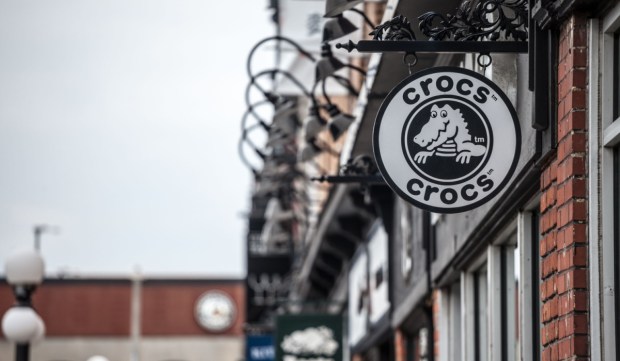Crocs Banks on Collaborations to Boost D2C Sales of Heydude

Crocs’ better-than-expected Q1 results are currently being attributed to the increasing consumer interest in casualization, comfort, sustainability, and personalization. During Q1, the comfort footwear company, which includes the Crocs and Heydude brands, revealed robust direct-to-consumer (D2C) growth for both labels. Crocs’ D2C revenue increased by 19% year-over-year, while Heydude, which was acquired by Crocs in early 2022, experienced D2C sales of $67.5 million, marking a significant surge of 141.1% from the previous year.
In addition to its growth, the company has reported that it will be employing a reliable D2C distribution strategy to expand its Heydude brand.
Crocs CEO Andrew Rees spoke to analysts during a conference call on Thursday, April 27, and stated that “the Q1 performance for both brands through D2C channels was exceptionally robust. This has instilled us with great confidence that our brands are highly sought after, and consumers are actively seeking them out in a unified branded setting.”
Starting in 2021, Crocs has placed a significant focus on D2C sales, streamlining certain wholesale partnerships in favor of direct channels. In April of that year, the company revealed that it would be ending its relationships with several long-standing wholesalers to prioritize key partners that could boost the brand’s market position.
Following the acquisition of Heydude by the company, its executives have implemented a distribution strategy that is seemingly similar to the former’s. Recent reports also indicate that Heydude has decided to sever ties with certain wholesale partners and concentrate on D2C sales.
Employing Strategies That Work
Beyond leveraging the handy-dandy D2C playbook, Crocs has been known to employ a type of strategy that only very few seem to nail — collaborations.
Most recently, Crocs revealed the extension of its tie-up with renowned designer Salehe Bembury.
As part of the agreement, Bembury is expected to take on the role of creative director for the Crocs x Pollex Pod collection, collaborating with Crocs’ design team to enhance his successful Pollex design and introduce new silhouettes and styles to the collection in the years to come.
Bembury has gained recognition in the fashion industry in recent years for his groundbreaking designs that not only aim to push boundaries but also prioritize the consumer experience. Bembury initially collaborated with Crocs in 2021 with the release of the Crocs Pollex Clogs which has since been dubbed one of the brand’s most successful in recent years.
See also: Why Collaboration Works for Crocs and Not Adidas
Crocs President Michelle Poole acknowledged the success of the partnership and revealed that collaborations and product partnerships have been a crucial component of the brand’s strategy for several years. She also stated that Bembury’s creative approach has added a new dimension to the molded form of the shoes, enabling them to appeal to a broader audience.
In the past, Crocs has collaborated with high-end fashion brand Balenciaga and musicians such as Post Malone, Justin Bieber and Bad Bunny.
That said, Crocs announced in February that it had experienced a 53.7% year-over-year revenue growth in 2022, surpassing its previous forecast of 49% to 52% growth. Furthermore, the company anticipates a revenue increase of 10% to 13% in 2023.
See also: Crocs Sees 53% Growth by Meeting Consumer Demand for Casualization
During that period, specialty athletic retailer Foot Locker also noted a similar trend, with consumers showing a preference for casual clothing. According to Foot Locker, sales of sneakers increased due to the products’ fun and laid-back nature.
“We’re at the intersection of sports, fitness, fashion and the casualization of society — and the tailwinds for sneakers, I believe, will be persistent for many years to come,” Foot Locker President and CEO Mary Dillon said in November.
Marrying D2C and Collaborations
According to Rees, the aim is to follow the footsteps of D2C-oriented enterprises such as Nike and Adidas by targeting “major leadership accounts” that can help enhance the brand’s reputation.
Rees mentioned that Heydude’s international expansion plan would emulate Crocs’ strategy. In other words, if Crocs mainly employs a D2 model in a particular country, Heydude would then adopt the very same approach. The company also plans to test this approach in various markets across Europe, the Middle East, Africa, and Latin America throughout the year.
“The consumer love for the Heydude brand is exceptional, and we remain confident about realizing the full potential the Crocs playbook will have on the brand,” said Crocs CFO and EVP Anne Mehlman.
Crocs announced its Q1 earnings, revealing revenues of $884.2 million, representing a 36.2% increase on a constant currency basis. Additionally, the company reported adjusted diluted earnings per share of $2.61, indicating a 27.3% surge.
